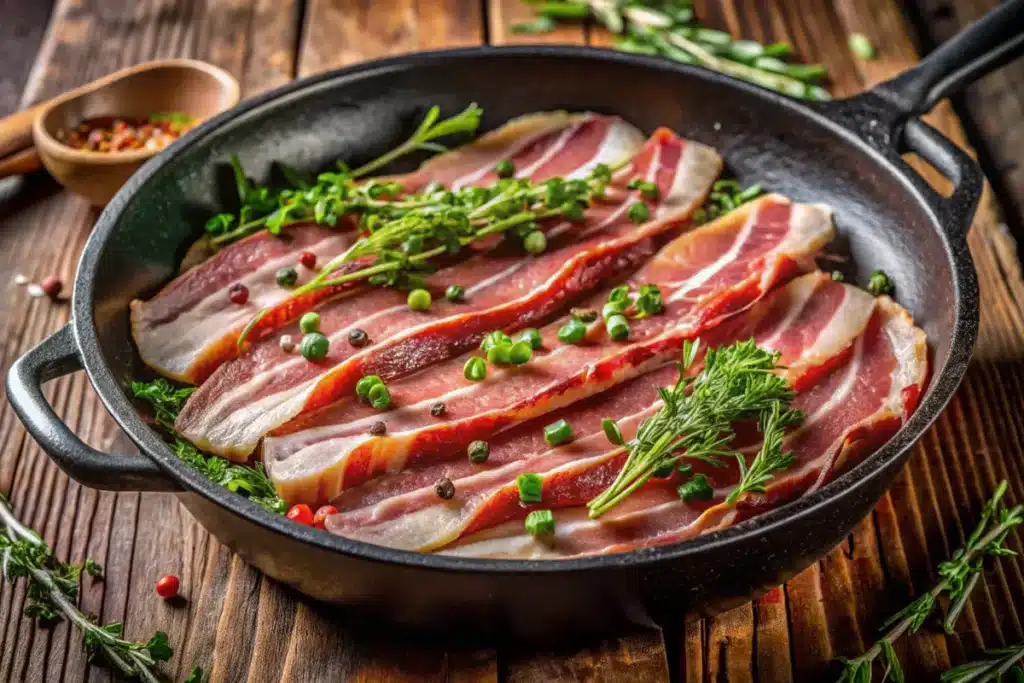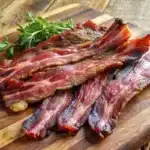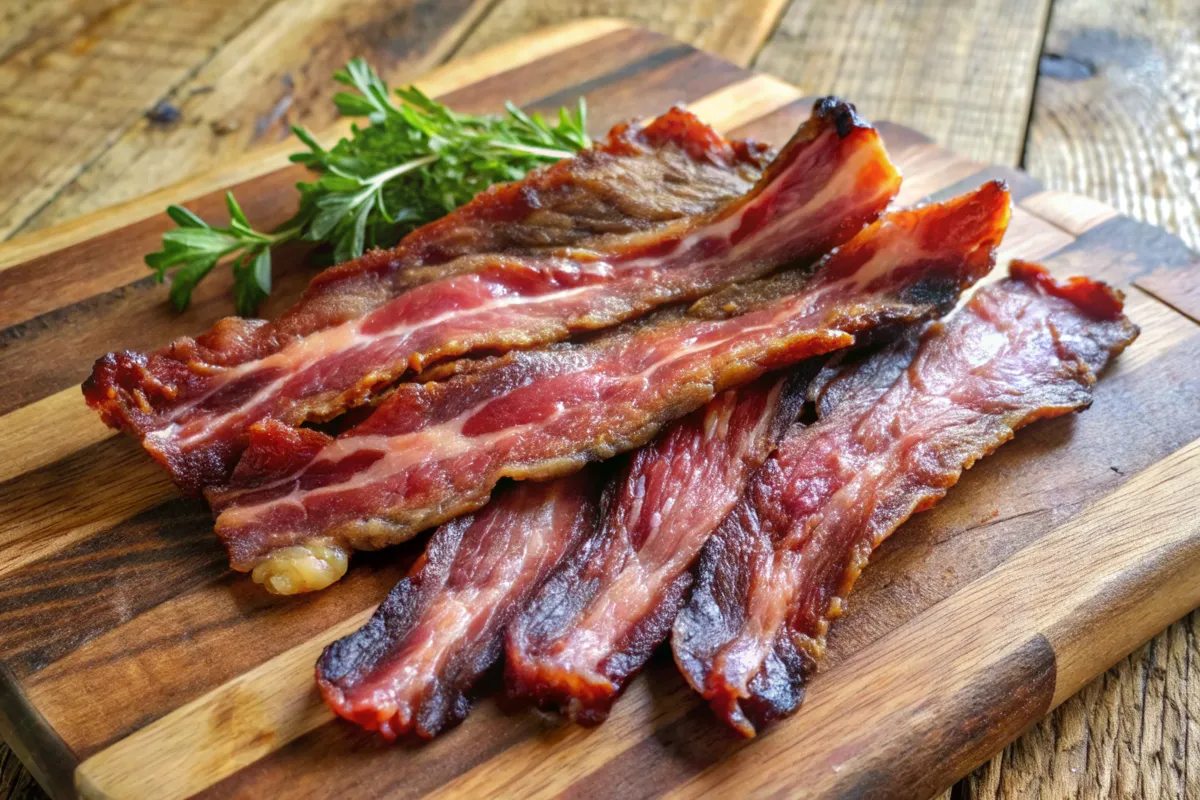Written by Sarah Miller
Making the switch from traditional pork bacon to beef bacon is increasingly popular among home cooks and professional chefs alike. Indeed, with its unique flavor and appealing texture, beef bacon offers a savory experience that suits a variety of dishes. Moreover, people appreciate the flexibility it brings to both classic and modern recipes. This in-depth guide aims to elucidate everything about beef bacon, from selecting the best cut to crafting homemade variations.
Furthermore, this article will walk you through the techniques needed to cook and preserve Brisket bacon in ways that maximize both flavor and nutritional benefits. Notably, we will also explore its global presence, health advantages, and the reasons behind its rising popularity. If you have always wondered how to incorporate Non-pork bacon into your daily cooking routine, then keep reading for detailed insights. For additional tips on various bacon types, feel free to check out this complete guide on bacon varieties from our previous content.
What Is Beef Bacon?
Beef bacon is, quite simply, bacon made from beef instead of pork. While its taste can resemble the savory richness of traditional pork bacon, it also carries the distinct flavor that only quality beef can provide. Consequently, the final product tends to have a denser texture and a more pronounced meaty profile. Despite having roots in certain culinary traditions for centuries, Non-pork bacon is now emerging as a sought-after alternative in mainstream kitchens. Additionally, people who prefer to avoid pork for dietary or cultural reasons often turn to Brisket bacon as a flavorful option.
In many cases, Non-pork bacon is made from cuts such as brisket, plate, or flank. These sections are then cured, smoked, and sometimes seasoned to create a product reminiscent of standard bacon strips. However, the flavorful intensity of Non-pork bacon sets it apart, making it a fantastic addition to sandwiches, breakfast plates, and even salads. Moreover, the popularity of beef bacon has soared over the years, driven not only by the need for pork alternatives but also by the rise of adventurous cooking trends around the world.
How Is Beef Bacon Made?
To prepare beef bacon, producers start with a suitable cut of beef, often focusing on fattier sections that can mimic the marbling found in pork belly. First, the beef is trimmed to remove excess fat or connective tissue. Next, a curing mixture composed of salt, sugar, nitrates, and various spices is applied to the trimmed meat. This curing stage can last anywhere from a few hours to several days, depending on the desired flavor and texture. Afterward, the meat is carefully rinsed to remove excess salt before moving on to the smoking process.
During smoking, the beef is exposed to low heat and aromatic wood smoke for a designated period. This step not only imbues beef bacon with a signature smoky quality but also extends its shelf life. Furthermore, smoking draws out some of the moisture, contributing to a denser, chewier bite. Finally, the bacon is cooled, sliced, and packaged, making it ready for the consumer to cook in their own kitchens. If you are interested in crafting your own cured meats at home, consider reading this comprehensive guide on homemade bacon cures from our previous content.
The Rise of Beef Bacon in Modern Cuisine
In recent years, Brisket bacon has gained mainstream traction, largely due to evolving food trends and a growing demand for alternatives to pork. Chefs in cutting-edge restaurants often showcase beef bacon in creative, high-end dishes that place emphasis on texture, mouthfeel, and bold flavors. Additionally, many consumers appreciate the flexibility it provides in meeting specific dietary requirements—whether it is a cultural restriction on pork or a personal preference for beef’s robust taste.
Moreover, social media platforms have boosted the hype around Brisket bacon, as food enthusiasts frequently share enticing photos and recipes. This digital exposure has significantly broadened its audience, turning a niche product into a household name. Consequently, grocery stores and specialty food markets now carry an array of beef bacon brands, offering consumers the chance to experiment with different seasonings, smoking methods, and cuts. In fact, numerous home chefs find Non-pork bacon an ideal gateway to more inventive cooking approaches.
Health Benefits
While non-pork alternative still contains fats and should be eaten in moderation, it can offer certain nutritional advantages over traditional pork bacon. Because beef is naturally rich in protein, each slice delivers essential amino acids that contribute to muscle repair and development. In addition, beef provides vital minerals such as iron and zinc, which are necessary for energy production and immune function.
Furthermore, people who monitor their sodium intake might notice that Non-pork bacon can sometimes have less salt compared to certain pork bacon brands—especially if you opt for a low-sodium variety. Nevertheless, it is important to read labels and be mindful of portion sizes, because all forms of bacon tend to be high in saturated fats. Yet, when enjoyed responsibly, beef bacon allows for a flavorful experience that fits into many balanced diets. If you are exploring more protein-rich options, you may want to explore these healthy high-protein meal tips from our previous content.
Choosing the Best Cut of Beef for Bacon
Selecting the right cut is paramount when making non-pork alternative. Often, belly cuts or brisket provide a balanced ratio of fat to muscle, which yields a tender bite after curing and smoking. However, some prefer to use the plate or flank sections, as they can offer a slightly leaner profile without sacrificing flavor. Consequently, your decision will hinge on your preference for either a fattier or leaner end product.
Additionally, marbling is a critical factor in determining taste and texture. Cuts with consistent marbling tend to develop richer flavor notes, especially after being exposed to salt and smoke. Moreover, picking high-quality beef—ideally grass-fed—can elevate the overall flavor of the bacon. Before committing to a specific cut, consider discussing your options with a knowledgeable butcher who can guide you toward the most suitable piece for your Non-pork bacon adventure.
How to Cook Beef Bacon Perfectly

Cooking non-pork alternative to perfection often involves balancing crispiness with the meat’s innate chew. One effective way to achieve this is by using an oven set to around 375°F (190°C). By placing the strips on a wire rack over a baking sheet, you allow the excess fat to drip away, ensuring a crunchy finish. Baking for approximately 12 to 15 minutes, flipping halfway, usually results in an ideal texture. However, personal preference can lead some to reduce or increase the cooking time slightly.
Alternatively, stovetop cooking in a cast-iron skillet provides a more hands-on approach, allowing you to monitor browning levels easily. In this method, start with medium-low heat and cook the beef bacon slowly, flipping occasionally to avoid burning. For those who prefer an even lower-fat result, consider draining the pan as you go. In any case, remember that cooking times can vary based on thickness, so always observe the strips to ensure your desired doneness.
Spice and Seasoning Options for Homemade Beef Bacon
Spices play a pivotal role in enhancing the flavor profile of Brisket bacon. In addition to the standard salt and pepper, you can try using chili flakes, onion powder, garlic powder, and even unusual mixtures like ras el hanout. Furthermore, ingredients such as smoked paprika or liquid smoke can bolster the bacon’s natural smokiness. By mixing and matching your favorite seasonings, you can craft a distinctive taste that complements your preferred cooking style.
Additionally, sweetness can be introduced using brown sugar or maple syrup, creating a caramelized finish when cooked. This sugary contrast pairs exceptionally well with the savory depth of Non-pork bacon. For an Asian-inspired twist, consider incorporating soy sauce, ginger, or sesame oil into your cure or marinade. Ultimately, the seasoning choices are limitless, which enables you to customize your homemade Non-pork bacon to your exact culinary preferences. For more ideas on seasoning blends, see these spice rub inspirations from our previous content.

Beef Bacon vs. Turkey Bacon: A Comparison
When compared to turkey bacon, beef bacon typically boasts a richer, meatier flavor and a texture that more closely mimics traditional pork bacon. In contrast, turkey bacon often feels lighter and can lack the robust savory notes that beef naturally provides. Additionally, the fat content in Non-pork bacon contributes to a crispy exterior and a succulent interior, whereas turkey bacon can sometimes turn out drier if not cooked with extra care.
Nevertheless, turkey bacon appeals to those seeking a leaner alternative, as it generally contains fewer overall calories and fats. Yet, in terms of flavor intensity, Brisket bacon wins for those craving a hearty and satisfying mouthfeel. Furthermore, many individuals find that beef bacon pairs exceptionally well with hearty breakfast dishes, gourmet sandwiches, and even as a soup garnish. If flavor is your priority and you are not restricted by dietary concerns, Beef belly bacon often stands as the more indulgent option.
Storing and Preserving
Proper storage is crucial to maintain the freshness and flavor of Non-pork bacon. Once opened, keep the strips in an airtight container or resealable plastic bag. Moreover, placing them in the coldest part of your refrigerator helps extend their shelf life. In general, uncooked beef bacon can last about a week in the fridge, while cooked slices might remain safe for three to four days. However, always rely on appearance and smell as additional indicators of freshness.
Freezing is another effective preservation method. By wrapping your Non-pork bacon tightly in freezer-safe packaging, it can remain viable for up to two months. Before cooking, thaw it overnight in the refrigerator to retain the best possible texture. Additionally, slicing the bacon before freezing can simplify meal prep; you can pull out just as many strips as needed. For extended storage and curing tips, see this post on meat preservation methods from our previous content.
Common Uses
Crispy Brisket bacon works wonders in a classic breakfast spread, including eggs, toast, and roasted tomatoes. However, its possibilities extend far beyond morning meals. Many chefs utilize Brisket bacon bits as a topping for salads, imparting a salty crunch that contrasts with fresh greens. Additionally, wrapping items like asparagus or shrimp in thin beef bacon slices infuses them with a smoky, hearty accent.
Furthermore, Beef belly bacon can enhance burgers, sandwiches, and sliders by adding both texture and flavor. It also finds a welcome spot in pasta dishes like carbonara, replacing pork-based ingredients for those seeking pork-free alternatives. Moreover, you can crumble cooked Non-pork bacon over soups, baked potatoes, and casseroles for a delicious garnish. Clearly, the versatility of beef bacon lends itself to a myriad of recipes, which makes it an excellent addition to almost any kitchen repertoire.
Beef Bacon in Global Cuisines
Although Beef plate bacon has long been prevalent in Middle Eastern and some Asian cuisines due to dietary restrictions on pork, it has gradually made its way into Western menus. Today, you might find it wrapped around dates in upscale tapas bars or thinly sliced on gourmet pizzas in artisan pizzerias. Additionally, chefs specializing in fusion cooking employ Non-pork bacon to marry flavors from different continents, resulting in unique culinary creations.
In South American cuisine, beef bacon is sometimes featured alongside grilled steaks or served as a part of an elaborate barbecue spread. Meanwhile, in regions where pork is less common, Brisket bacon stands as the go-to substitute to achieve that signature smoky-salty taste. Indeed, the global acceptance of Non-pork bacon speaks volumes about its adaptability. Furthermore, its continued rise in popularity is a testament to how food cultures evolve through innovative substitutions and international inspiration.
Making Beef Bacon at Home
Creating your own beef bacon at home can be an exciting project that lets you tailor the taste exactly to your liking. First, start by selecting a high-quality beef cut. Then, prepare a cure with salt, sugar, and any spices you desire. Moreover, place the beef in a sealable container, ensuring it’s evenly coated with your chosen cure. Refrigerate for several days, flipping the meat daily so that each side absorbs the curing mixture.
After curing, rinse the beef thoroughly and pat it dry. The next step often involves smoking it over a low heat source, such as applewood or hickory chips, until it reaches a safe internal temperature. Alternatively, you can bake or slow-cook it if you lack smoking equipment. Once fully cooked, chill the Non-pork bacon for easier slicing. Finally, store your homemade strips in the fridge or freezer, ready to be fried, baked, or grilled for a sumptuous meal.
Common Mistakes
One frequent mistake is overcooking beef bacon. Because beef can dry out more quickly than pork, using excessively high heat or leaving the strips in the pan for too long can result in a tough, unappetizing texture. Therefore, it is advisable to cook Non-pork bacon gradually at a moderate temperature, checking frequently to prevent burning. Another error involves using too little oil or fat in the pan, which can contribute to sticking and uneven cooking.
Additionally, people sometimes forget to account for the thickness of the beef bacon slices. Thicker cuts may require more time or a slightly lower temperature to cook thoroughly without drying out. Conversely, thin slices can burn quickly if you are not careful. Lastly, be mindful of salt levels, especially if you’re using a salted cure. Always taste as you cook and adjust seasonings accordingly. For more cooking troubleshooting, visit this essential guide on mastering cooking techniques from our previous content.
FAQ:
1. Why Is It So Hard to Find u003cemu003eBeef Baconu003c/emu003e?
Finding u003cemu003ebeef baconu003c/emu003e can be challenging, primarily because pork bacon remains the most common choice on supermarket shelves. Moreover, u003cemu003ebeef baconu003c/emu003e requires specific cuts, such as brisket or short plate, which are not as readily mass-produced for bacon-style products. Consequently, many local stores might stock only limited quantities—or none at all—depending on demand. Furthermore, some butchers and specialty meat suppliers focus on traditional pork bacon simply due to higher customer familiarity.u003cbru003eTo locate u003cemu003ebeef baconu003c/emu003e, you can:u003cbru003eAsk a local butcher if they can custom-cut or cure beef for bacon.u003cbru003eSearch online marketplaces or specialty grocery stores for ready-made options.u003cbru003eCheck ethnic or Halal markets, as u003cemu003ebeef baconu003c/emu003e often appears where pork is avoided.
2. Does u003cemu003eBeef Baconu003c/emu003e Taste Like Regular Bacon?
u003cemu003eBeef baconu003c/emu003e shares certain smoky, savory notes with pork bacon, yet it provides a richer, meatier flavor that some people find even more satisfying. Consequently, its texture can be denser, offering a chewy bite compared to typical pork bacon. However, the overall taste aligns closely with the bacon experience, especially if cured and smoked similarly. Additionally, how u003cemu003ebeef baconu003c/emu003e is seasoned and cooked can influence whether it takes on a robust or more mellow taste.u003cbru003eIn other words, if you crave that classic bacon aroma and crispness, u003cemu003ebeef baconu003c/emu003e can deliver a comparable yet distinct alternative that appeals to those who enjoy a hearty flavor.
3. Why Is There No More u003cemu003eBeef Baconu003c/emu003e?
Some regions seem to have phased out u003cemu003ebeef baconu003c/emu003e due to production logistics and consumer demand. Often, pork bacon outperforms u003cemu003ebeef baconu003c/emu003e in popularity, making it more profitable for producers. However, many consumers remain unaware that u003cemu003ebeef baconu003c/emu003e exists, causing lower sales in typical grocery outlets. Additionally, store-bought u003cemu003ebeef baconu003c/emu003e demands specialized curing processes, which can be more costly.u003cbru003eNevertheless, u003cemu003ebeef baconu003c/emu003e is still available through certain butchers and artisan producers. In fact, many enthusiasts opt to create their own, curing and smoking beef cuts themselves for a fresher, customizable option.
4. Is u003cemu003eBeef Baconu003c/emu003e Healthy?
u003cemu003eBeef baconu003c/emu003e can be part of a balanced diet if enjoyed in moderation. Because beef is naturally protein-rich, it delivers essential amino acids that support muscle health. Moreover, u003cemu003ebeef baconu003c/emu003e provides vital minerals such as iron and zinc. However, it still contains saturated fat and sodium, so choosing leaner cuts and low-sodium varieties can help maintain a healthier profile.u003cbru003eFurthermore, pairing u003cemu003ebeef baconu003c/emu003e with nutritious sides—like fresh vegetables or whole grains—elevates the meal’s overall nutritional value. For more tips on crafting balanced meals, see u003ca href=u0022https://momtasty.com/high-protein-meal-tips/u0022u003ethis helpful guide on balanced protein recipesu003c/au003e from our previous content.
5. What Is Another Name for u003cemu003eBeef Baconu003c/emu003e?
u003cemu003eBeef baconu003c/emu003e occasionally appears under alternative labels referencing its production method or cut. Some artisan producers call it “cured beef belly” or “beef plate bacon,” especially if it originates from the plate section. Nonetheless, most suppliers use the straightforward name u003cemu003ebeef baconu003c/emu003e to describe the product.u003cbru003eIn certain regions, people may simply advertise it as “bacon made from beef” to emphasize its pork-free status. Ultimately, any label should indicate a curing and smoking process similar to traditional bacon, preserving that crispy, salty appeal.u003cbru003eu003cstrongu003eLooking for more tips?u003c/strongu003e Explore this post on bacon varieties and cooking tips to discover additional insights on how to elevate your next u003cemu003ebeef baconu003c/emu003e experience.
Conclusion
In essence, Brisket bacon represents a flavorful, versatile alternative to traditional pork bacon, offering a richer, more robust taste profile. Whether you choose to explore artisanal Non-pork bacon at specialty markets, experiment with spices in a homemade cure, or simply cook up a few strips for breakfast, the options are nearly endless. Furthermore, Brisket bacon can easily integrate into a variety of global cuisines, from South American barbecues to Middle Eastern feasts.
Finally, mastering the art of Non-pork bacon involves understanding cuts, curing methods, cooking temperatures, and proper storage. By paying attention to these factors, you can elevate your meals with the distinctive taste that only beef bacon provides. For more insights and additional cooking inspiration, make sure to revisit our previous content on bacon varieties and cooking tips. Embrace the rise of Non-pork bacon and enjoy the multitude of culinary experiences it can bring to your table.

Beef Bacon
Ingredients
For the Cure
- 1 cup Salt For brining
- 1 cup Sugar Brown sugar can be used for a sweeter profile
- 1 tablespoon Nitrates For preservation and color
- 2 tablespoons Black pepper Freshly ground for best flavor
- 1 tablespoon Chili flakes Optional, for a spicy kick
For Cooking
- 1 pound Beef brisket Choose a cut with good marbling
Instructions
Preparation
- Trim beef brisket to remove excess fat and connective tissue.
- Mix salt, sugar, nitrates, pepper, and chili flakes in a bowl to create the curing mixture.
- Apply the curing mixture evenly over the brisket and place it in a sealable container.
- Refrigerate for several days, flipping the brisket daily.
- After curing, rinse the brisket thoroughly and pat it dry.
Smoking
- Smoke the brisket over low heat with wood chips until it reaches a safe internal temperature.
- Alternatively, bake the cured brisket in an oven at 375°F (190°C) until cooked.
Serving
- Chill the cooked beef bacon for easier slicing.
- Fry, bake, or grill slices before serving. Enjoy in sandwiches, salads, or breakfast dishes.
